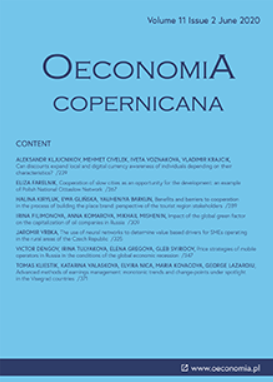The banking sector as the absorber of the COVID-19 crisis’ economic consequences: perception of WSE investors
The banking sector as the absorber of the COVID-19 crisis’ economic consequences: perception of WSE investors
Author(s): Michał Bernardelli, Zbigniew Korzeb, Paweł NiedziółkaSubject(s): Business Economy / Management, Economic policy, Health and medicine and law, Financial Markets
Published by: Instytut Badań Gospodarczych
Keywords: banking sector; commercial banks; Warsaw Stock Exchange; COVID-19;
Summary/Abstract: Research background: The paper focuses on the research of investors’ decisions with regard to shares of all 12 banks listed on the Warsaw Stock Exchange during the first half of 2020. It examines the behavior of a subindex reflecting bank shares’ prices against the main WIG index WIG and 14 sector subindices. The authors identify groups of banks with different investors’ responses. They also classify banks into separate groups on the basis of changes in the fundamental indicators describing their economic and financial performance. The study concentrates mainly on the verification of the stability of this attribution, explaining reasons for its modifications over time. Purpose of the article: To identify the characteristics of bank clusters determining different capital market responses to their listed shares and to explain the reasons for volatility in investors’ behavior within the analyzed period. Methods: The methodology of the research can be described in three areas. The first is the statistical analysis with the emphasis on the use of a quarter range to capture changes in the volatility of share prices. The second area is the clustering k-means method based on the interpolated — from quarterly to daily — measures of the bank’s financial condition. This mathematical approach is a novelty in finance and economics. The last, third, area is forecasting with the use of linear regression analysis, which is the key factor in determining the abnormal rates of return. The indicated areas are combined through a generally understood correlation analysis. Findings & value added: Large retail banks have been less affected compared to medium-sized ones with relatively rich corporate portfolios. The initial market reaction reflected concern about the resistance to the crisis of poorly capitalized banks with mean liquidity buffers. Upon the announcement of government support, investors’ approach to the shares of banks of differentiated economic and financial performance conformed accordingly. These findings are valuable in the long term especially from the perspective of supervision authorities’ policy during external shocks. The presented study suggests designing flexible and tailor-made regulatory approach aligned with the defined bank clusters. Its value added also consists in proposing a new method of analysis, combining interpolation and automatic clustering, which has proved to be adequate for the study of a bank’s financial condition based on daily frequency data.
Journal: Oeconomia Copernicana
- Issue Year: 12/2021
- Issue No: 2
- Page Range: 335-374
- Page Count: 40
- Language: English

